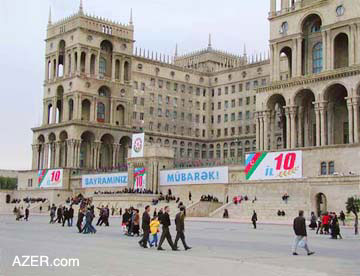|

Winter 2001 (9.4)
Evolution of
Consciousness
Ten Years
After the Collapse of the Soviet Union
by Betty
Blair
  Fifty years from now,
historians are likely to identify December 8, 1991 as the actual
date that the Soviet Union collapsed. On that day, the leaders
of Belarus, Ukraine and Russia met in the Bela Vezha Forest [Belarus]
and drew up a document, now referred to as the Bela Vezha Agreement,
stating that "the Soviet Union as a geopolitical reality
and a subject of international law has ceased to exist." Fifty years from now,
historians are likely to identify December 8, 1991 as the actual
date that the Soviet Union collapsed. On that day, the leaders
of Belarus, Ukraine and Russia met in the Bela Vezha Forest [Belarus]
and drew up a document, now referred to as the Bela Vezha Agreement,
stating that "the Soviet Union as a geopolitical reality
and a subject of international law has ceased to exist."
But the actual process of disintegration, many Azerbaijanis would
suggest, began nearly two years earlier for them with the tragic
events of Black January (January 19-20, 1990), when Soviet troops
under orders from Soviet leader Mikhail Gorbachev suddenly descended
on the streets and indiscriminately killed civilians to quell
what was described as the unruliness of Azerbaijanis demonstrating
for independence.
This unprovoked slaughter numbed the Azerbaijani people. Officially
132 people died that night, but no one doubts that the casualties
were grossly underreported and that many bodies were dumped into
the sea to conceal the terrible massacre. Today, mystery still
shrouds that event, in terms of the actual facts and figures.
But one thing is clear: for hundreds of thousands of Azerbaijanis,
perhaps even millions, the Soviet Union ceased to exist beginning
on that tragic night.
It was an automatic decision. Azerbaijanis simply lost faith
in the system, concluding that the "Brotherhood of Nations"
the USSR had claimed for the 15 Soviet republics had grossly
abused their rights as citizens. Many Communist Party members
in Azerbaijan burned their ID cards in protest, giving up many
privileges that they had worked hard to achieve. There was no
turning back. And thus it was Black January that gave birth to
an evolution of consciousness in Azerbaijan that eventually did
lead to its independence.
  In both the Autumn and
Winter 2001 issues (AI 9.3 and AI 9.4) of our magazine, we have
reflected on this ten-year process of shaking off the shackles
of a totalitarian system and grappling with the concept of independence.
In the course of interviewing people and translating and editing
articles, we've noted two distinct patterns emerging in what
we've entitled "The Evolution of Consciousness." In both the Autumn and
Winter 2001 issues (AI 9.3 and AI 9.4) of our magazine, we have
reflected on this ten-year process of shaking off the shackles
of a totalitarian system and grappling with the concept of independence.
In the course of interviewing people and translating and editing
articles, we've noted two distinct patterns emerging in what
we've entitled "The Evolution of Consciousness."
The first tendency has to do with Azerbaijanis forging international
ties, breaking down those walls that once imprisoned and separated
them from the rest of the world. The West called it the "Iron
Curtain"; Azerbaijanis often referred to it as an "Information
Blockade" that prohibited them from communicating and meeting
with outsiders. During this past decade, Azerbaijanis have moved
rather quickly beyond their territorial borders to establish
international ties, starting with the very intense itinerary
that Heydar Aliyev pursued, especially during the early years
of his Presidency, to visit foreign Heads of State, build relations
and sign contractual agreements in economic, political and cultural
spheres.
Above: Azerbaijan celebrating
Ten Years since the Collapse of the Soviet Union in November
2001 in front of the Government Building.
The spirit of internationalism is not something new. It has existed
deep within their soul for millennia. Located at a strategic
trading crossroads of east and west, north and south, Azerbaijan
has long prided itself on its hospitality to strangers. It's
just that the Soviet system banned those ties for all except
the privileged few who became emissaries or token representatives
to demonstrate the superiority of the Soviet system.
The second trend that we've observed relates to Azerbaijanis
finally being able to look deep within themselves to discover
who they are as a people and as a nation. Clearly, they are grappling
with the question of identity. This is leading to a revival of
interest in the Azeri language, culture, music, folklore, history,
archeology - you name it. During the Soviet regime, delving into
one's national roots was prohibited for the sake of the "greater
good of that vast nation" that encompassed many nationalities
and stretched across 12 time zones. Other former Soviet Republics
complain about the same thing today. But without understanding
their own roots, how can Azerbaijanis or the people of any other
Republics succeed in building their own futures? How much will
they be able to recover that hasn't already been intentionally
obliterated over these past 70 years? How much will historians
be able to piece back together? How much has been erased from
the collective memory forever?
When we began publishing Azerbaijan International magazine in
1993, we didn't realize that our efforts would produce one of
the most reliable, consistent and comprehensive accounts in English
of Azerbaijan's process of rebirth. It's been a fascinating journey
to witness and record the founding of a new nation. We hope the
articles that follow provide our readers with invaluable glimpses
into this incredible historical phenomenon.
____
From Azerbaijan
International
(9.4) Winter 2001.
© Azerbaijan International 2002. All rights reserved.
Home | About
Azeri | Learn
Azeri | Arabic
Script | Store | Contact
us
Other Web sites
created by Azerbaijan International
AZgallery.org | AZER.com | HAJIBEYOV.com
|